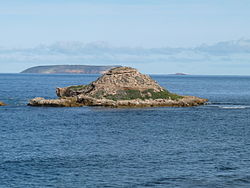 Chinamans Hat Island as viewed from the nearby coastline | |
| Geography | |
|---|---|
| Location | Investigator Strait |
| Coordinates | 35°17′20″S136°55′05″E / 35.28876°S 136.91795°E |
| Administration | |
Australia | |
Chinamans Hat Island is an islet located off the south coast of Yorke Peninsula in Investigator Strait in South Australia about 2.4 kilometres (1.5 miles) south-west of Stenhouse Bay and within 350 metres (1,150 feet) of the shore. As of 2014, it is located within the Innes National Park.
